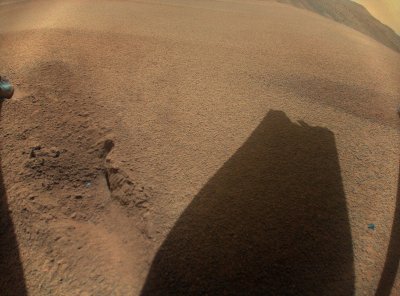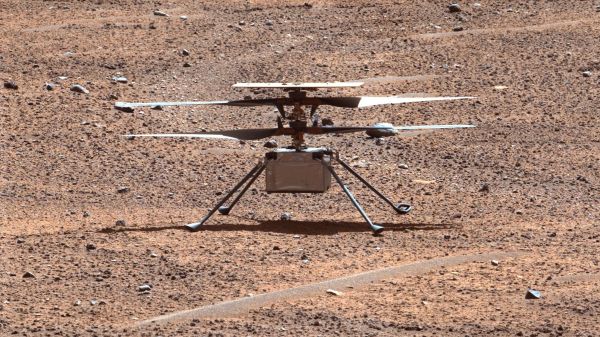 One of the most sought after substances in the Universe is water – especially in its liquid form – as its presence on a planet makes the presence of life (as we know it) significantly more likely. While there are potentially oceans worth of liquid water on e.g. Jupiter’s moon Europa, for now Mars is significantly easier to explore as evidenced by the many probes which we got onto its surface so far. One of these was the InSight probe, which was capable of a unique feat: looking inside the planet’s crust with its seismometer to perform geophysical measurements. These measurements have now led to the fascinating prospect that liquid water may in fact exist on Mars right now, according to a paper published by [Vashan Wright] and colleagues in PNAS (with easy-read BBC coverage). Continue reading “Possible Discovery Of Liquid Water In Mars’ Mid-Crust By The Insight Lander”
One of the most sought after substances in the Universe is water – especially in its liquid form – as its presence on a planet makes the presence of life (as we know it) significantly more likely. While there are potentially oceans worth of liquid water on e.g. Jupiter’s moon Europa, for now Mars is significantly easier to explore as evidenced by the many probes which we got onto its surface so far. One of these was the InSight probe, which was capable of a unique feat: looking inside the planet’s crust with its seismometer to perform geophysical measurements. These measurements have now led to the fascinating prospect that liquid water may in fact exist on Mars right now, according to a paper published by [Vashan Wright] and colleagues in PNAS (with easy-read BBC coverage). Continue reading “Possible Discovery Of Liquid Water In Mars’ Mid-Crust By The Insight Lander”
mars107 Articles
Photo Shows Real Spiders From Mars
A cornerstone of early 1970s rock music culture was the British singer David Bowie in his Ziggy Stardust persona, along with his backing band the Spiders from Mars. You can tell that the PR department at the European Space Agency were beside themselves with glee at the opportunity to reference them when their Mars Express spacecraft snapped a picture of some of the planets surface structures which bear a passing resemblance to Earth-bound spiders. We can’t blame them, we’d have done the same.
While these spiders are definitely not arachnid in origin, they are no less interesting. Over the Martian winter there form layers of carbon dioxide ice, which turn to gas under the influence of the Sun. This gas becomes trapped underneath layers of ice, until it forms sufficient pressure to burst through and escape. In doing so it brings up dark dust which settles along fissures in the ice, leading to the spider-like patterns when viewed from orbit.
So no life on Mars then, at least as yet. But it’s an interesting observation, and another little piece in the puzzle of understanding our planetary neighbor, as well as an excuse for a classic rock earworm. Meanwhile, this isn’t the first time we’ve reported on the ESA Mars probes.
NASA’s Ingenuity Mars Helicopter Transitions Into Stationary Testbed
On April 16th NASA announced the formal end to Ingenuity’s days as the first ever Martian helicopter, following its 72nd and final flight mission in January. This flight ended with a rough landing during which the helicopter’s blades got damaged and separated, leaving the plucky flying machine with its wings clipped. During the final meet-up of the Mars Helicopter Team there was cake, but none for Ingenuity as its latest data set was reviewed by the team from 304 million kilometers away. This data confirms the latest software patch allows it to work stand-alone as a data collection platform.
With these latest software changes, Ingenuity will wake up daily, activate its computers and perform a self-check of all its components before collecting sensor data and images. The main goal of this is to collect long-term performance data on the helicopter’s systems, with enough onboard memory to allow for measurements to be stored for around 20 years. This means that although the Perseverance rover will have to trundle on without its flying mission buddy, one day in the future another rover, helicopter or primate will presumably drop by to either communicate with Ingenuity if it’s still alive, or harvest its memory unit for data retrieval.
Thanks to [Mark Stevens] for the tip.
Heating Mars On The Cheap
Mars is fairly attractive as a potential future home for humanity. It’s solid, with firm land underfoot. It’s able to hang on to a little atmosphere, which is more than you can say about the moon. It’s even got a day/night cycle remarkably close to our own. The only problem is it’s too darn cold, and there’s not a lot of oxygen to breathe, either.
Terraforming is the concept of fixing problems like these on a planet-wide scale. Forget living in domes—let’s just make the whole thing habitable!
That’s a huge task, so much current work involves exploring just what we could achieve with today’s technology. In the case of Mars, [Casey Handmer] doesn’t have a plan to terraform the whole planet. But he does suggest we could potentially achieve significant warming of the Red Planet for $10 billion in just 10 years. Continue reading “Heating Mars On The Cheap”
Hackaday Links: February 4, 2024
Things may not have gone as planned last week for the flying cellphone on Mars, but just because Ingenuity‘s flying career is over doesn’t mean there’s no more work to do. NASA announced this week that it’s going to try a series of “wiggle” maneuvers on Ingenuity‘s rotors, in an attempt to get a better look at the damage to the blade tips and possibly get some clues as to what went wrong. The conjecture at the moment seems to be that a large area of relatively featureless terrain confused the navigation system, which uses down-facing cameras to track terrain features. If the navigation program couldn’t get a bead on exactly how far above the ground it was, it’s possible the copter came in too hard and caused the rotor tips to dig into the regolith. There seems to be some photographic suggestion of that, with what looks like divots in the ground about where you’d expect the rotor tips to dig in, and even scraps of material that look out of place and seem to be about the same color as the rotor blades. All this remains to be seen, of course, and we’re sure that NASA and JPL are poring over all available data to piece together what happened. As much as we hate to say goodbye to Ingenuity, we eagerly await the post-mortem.
Ingenuity May Be Grounded, But Its Legacy Will Be Grand
[Eric Berger] has a thoughtful and detailed article explaining why Ingenuity, NASA’s small helicopter on Mars, was probably far more revolutionary than many realize, and has a legacy to grant the future of off-world exploration that is already being felt.
Ingenuity was recently grounded due to rotor damage, having already performed far beyond the scope of its original mission. The damage, visible by way of a shadow from one of the rotors, might not look like much at first glance, but flying in the vanishingly-thin atmosphere of Mars requires the 1.18 meter (3.9 foot) carbon fiber blades to spin at very high speeds — meaning even minor rotor damage could be devastating.

[Eric] points out a lot that is deeply interesting and influential about Ingenuity. Not only is successful powered flight on another planet a real Wright brothers moment, but how Ingenuity came to be validates a profoundly different engineering approach for NASA.
To work in the space industry is to be constrained by mass. But even so, Ingenuity‘s creators had a mere four pounds to work with. That’s for rotors, hardware, electronics, batteries, solar panel — all of it. NASA’s lightest computer module alone weighed a pound, so engineers had no choice but to depart from the usual NASA way of doing things to get it done at all. Not everyone at NASA was on board. But Ingenuity worked, and it worked wonderfully.
Powered flight opens new doors, and not just for support roles like navigation planning. There’s real science that can be done if powered flight is on the table. For example, [Eric] points out that inaccessible terrain such as the Valles Marineris canyon on Mars is doubtlessly scientifically fascinating, but at 4,000 km long and up to 7 km deep, rover-based exploration is not an option.
So Long And Thanks For All The Flights: Ingenuity Permanently Grounded After 72 Flights
Just a few hours ago, NASA dropped some devastating news: Ingenuity will fly no more. Three years after dropping from the belly of the Perseverance rover and after 72 flights through the thin Martian atmosphere, the little helicopter that could now can’t, after having sustained damage to one or more of its rotors during its final landing.

NASA’s terminal diagnosis of Ingenuity comes from a photo from one of the helicopter’s cameras, which shows a chunk missing from the tip of one of its rotors, likely caused by a rough landing after transiting a flat, sandy area that may have confused the aircraft’s navigational cameras.
While this is anything but good news, it’s not at all unexpected and in a way long overdue. Ingenuity was designed for a primary mission of just five flights, which it accomplished all the way back in May of 2021. There was heavy speculation at the time that Ingenuity might not even do that; we can recall one of the team members suggesting the odds were that Ingenuity’s tenure as the first controlled powered flying machine on another world would end as twisted wreckage in the newest, smallest crater on Mars.
But happily, Ingenuity proved the oddsmakers — and possibly those wishing to temper expectations — spectacularly wrong. In fact, by the fourth flight, it was clear that Ingenuity was in it for the long haul, enough so that NASA redefined its mission to “operational demonstration” and gave it another 30 sols of flight time. This gave the team the flight time needed to prove the helicopter’s worth as a scout for Perseverance and not just a distracting sideshow from the primary mission of searching for signs of ancient life on Mars.
















